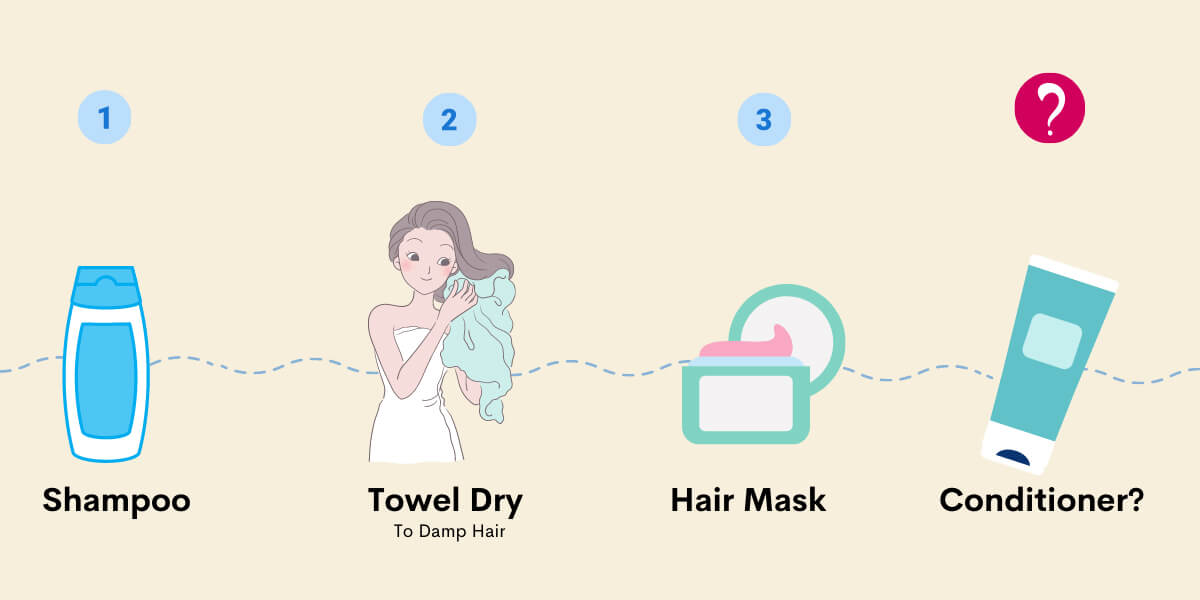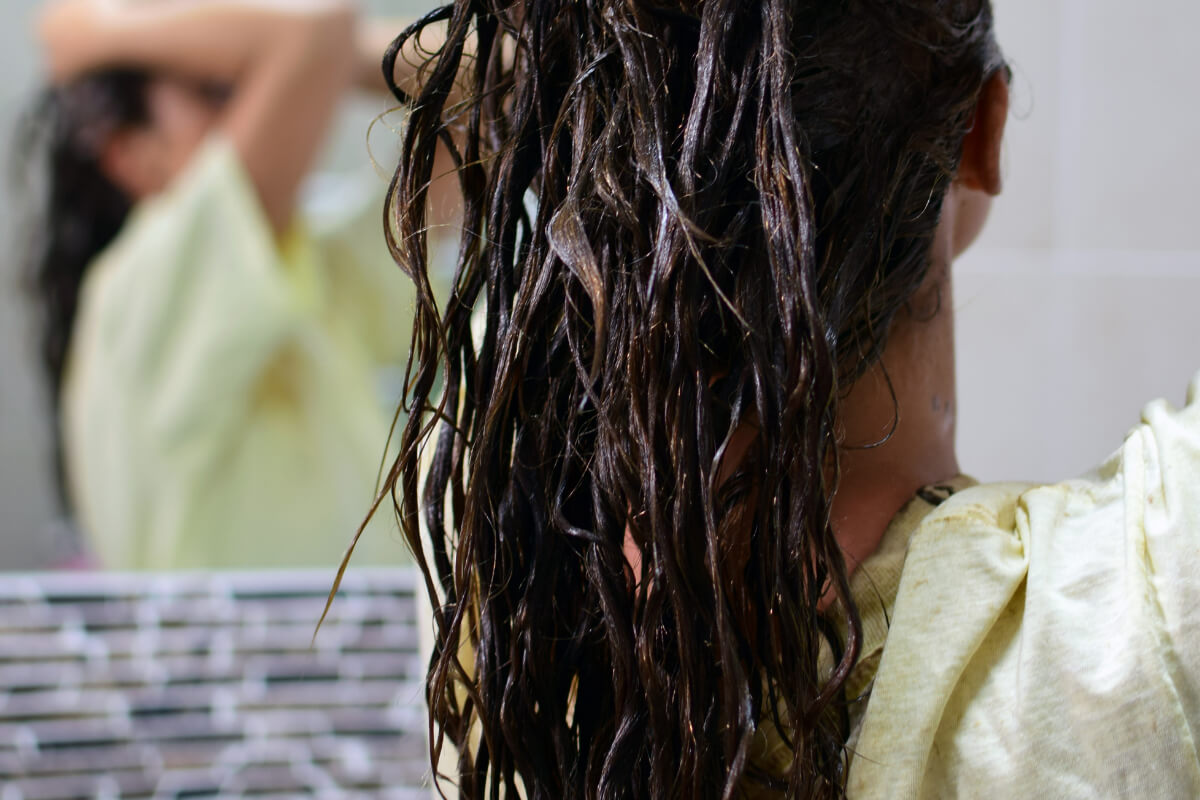Should You Use a Hair Mask Before or After Shampoo?
Updated on
This post may contain affiliate links. As an Amazon Associate, we may earn from qualifying purchases.

Over the last few months, I’ve tried 13 different masks on my hair, and here’s what I learned:
Always use a hair mask after your shampoo. Not before.
Unless the product instruction says otherwise, using a hair mask on clean and damp hair after shampooing makes the product more effective.
Use a Hair Mask After Shampoo
There’s a reason why professional hair stylists would deep cleanse the hair before doing a keratin or color treatment.
This process makes the hair ready and more receptive, which in turn delivers better results that last longer.

When you shampoo, the cuticles soften and lift off slightly due to surfactants that increase negative charges in the hair.
Human hair naturally has a negative charge.
Shampoos also contain negatively charged surfactants designed to pull away dirt, oil, and other positive charges from the hair and scalp.
So when you lather up, it’s a double whammy of negatives that make the hair cuticles swell and lift out slightly so that the detergents can cleanse in between.
This is why a conditioner is used right after shampoo to smooth down the cuticles and settle the hair. Without conditioner, the cuticles will remain open, causing frizz and tangles after your shower.
So if you want to apply a hair mask, it’s best to do so when your hair is damp and freshly shampooed. Gaps on the surface of the hair allow maximum moisture and nutrients to seep in.
Hair masks also contain cationic surfactants, which work in a similar way to conditioners. They help neutralize the negative charges from shampoos to flatten the cuticles back to their normal state.
Should You Use Conditioner After a Hair Mask?
Applying a conditioner after a hair mask depends on 3 things:
- The type of hair mask you’re using
- Is the mask acidic enough?
- The state of your hair
Type of Hair Mask
Intensive deep hydrating hair masks can keep the hair conditioned for longer as they contain smaller particles that absorb better. Therefore, applying a conditioner after the mask may overload moisture content, causing hygral fatigue in the hair.

Hygral fatigue means swelling and unswelling, which can stretch the cuticles to their limits, weakening the hair’s moisture retention ability.
If your hair mask is lightweight and recommends a follow-up conditioner to be used, then yes, you can use one.
State of the hair
If your hair is very porous (high porosity), you can simply swap your conditioner for a hair mask. Hair masks work like supercharged conditioners, making them 5X more effective at nourishing the hair while providing good slip for detangling.
Fine hair
If you have fine hair, using a mask instead of a conditioner will be far too intense and heavy. Either use a hair mask designed for fine hair OR a conditioner.
Avoid using both at the same time.
Thick, Dry, and Coarse Hair
The best product to use for dry, thick, and coarse hair is a revitalizing masque that works to soften rough-textured hair that is hard to manage and style.
An excellent product in this category is the CHI Luxury Black Seed Oil Revitalizing Masque, which clearly states that you should use a conditioner after for best results.
And most people who’ve reviewed this product agree. Conditioning the hair after this hair mask doubles up its effectiveness to leave your hair super soft and shiny.
CHI Luxury Black Seed Oil Revitalizing Masque
Color-Treated Hair
For colored hair, you can use a hair masque followed by a conditioner to preserve hair color intensity and softness.
However, most masques for color-treated hair combine the benefits of both.
It’s called the color conditioning masque.
So instead of wasting time applying a hair mask then conditioning your hair, why not try something like the Oribe cuticle-enriching color conditioning masque:
Oribe Color Conditioning Masque
Is a Hair Mask Better Than Conditioner?
Yes. Unlike regular conditioners, hair masks contain more potent ingredients broken down into smaller pieces to penetrate deeper into the hair shafts.
They are more intense, provide better moisture content, and can also help heal hair damage.
A hair conditioner, on the other hand, is just a counterbalance to shampoo. It works to neutralize negative charges in the hair and restores pH balance after washing.
How to use a Hair Mask after Shampooing

Once you’ve washed your hair, soak up the excess water with a smooth microfiber towel to avoid friction.
Your hair should be damp. Not soaking wet. Not too dry.
Then section your hair to make sure you get an even distribution without missing any parts. You may also use hair clips if your hair if you have long hair. This makes the process easier and more manageable.
Apply the hair mask generously from midlength to the ends, paying particular attention to the ends of the hair that are generally dryer and prone to breakage.
Massage the mask in downward motions thoroughly.
Once you’ve slathered all your strands, wrap it up with your microfiber towel and let it infuse for around 10 minutes.
Then rinse the mask out and allow your hair to air dry.
Can You Use A Hair Mask On Dirty Unwashed Hair?
No. Hair masks work better on clean and damp hair.
When you apply to unwashed hair, the hair cuticles are flat and possibly layered with sebum and other product residues that can block the mask ingredients from infiltrating the hair.
Another problem this may cause is extra buildup. If the hair mask can’t find its way through the cuticle layer, it stays on top and dries out, making your hair feel dull, flat, and brittle.
However, there are some exceptions. There are other types of hair masks like detox and deep cleansing ones, which can be used before.
When to Use a Hair Mask Before a Shampoo
Deep Cleansing and Detoxing
Masks that deeply cleanse the hair and scalp are more effective when used before shampoos. That’s because they are designed to scrub and exfoliate stubborn buildup and impurities from the scalp and hair that regular shampoos fail to do.
These masks are also known as pre-shampoo treatments.
You can use them to unclog the pores on your scalp, purify your strands, and exfoliate your scalp, then use your shampoo to rinse it all off.
Applying a detox mask before shampoo is okay. The mask is designed to break through the layer of dirt on the hair and scalp. These types of hair masks, unlike their conditioning counterparts, are not meant to absorb into the hair.
Once they’ve purged all the impurities, you can simply wash them off, and the job is done.
Pre Poo Hair Mask
As the name suggests, a pre-poo product is used before shampooing.
Pre-pooing is a treatment that helps to layer the hair with moisture before shampooing to prevent shampoo from stripping natural oils from the hair fibers and the scalp. This treatment works well for people with natural hair or those with high porosity hair.
Related: Pre-poo treatment for low porosity hair.
Best Hair Masks To Use
Here are some of the best hair masks I’ve handpicked from the 13 products I’ve tested:
Briogeo Don't Despair Repair Deep Conditioning Mask
This is the most intensive and deeply moisturizing hair mask I’ve used so far. It leaves your hair feeling smooth as silk!
Arvazallia Hydrating Argan Oil Hair Mask
Gisou Honey Infused Hair Mask
The Gisou honey-infused hair mask doesn’t just give moisture back – it also protects and strengthens your strands against heat damage.
Enriched with Wildflower Beeswax, Honey, minerals, vitamins, amino acids, and antioxidants, this product packs a solid punch of goodness into the hair.
The only problem is: The price will make you weep!
Moroccanoil Intense Hydrating Hair Mask
The Moroccanoil intense mask is perfect for hydrating dry and thick textured hair.
With its antioxidant-rich argan oil extracts, Linseed extracts, and Shea butter, this product can heal your hair from the rigors of daily stressors like heat styling and chemical treatments.
Hair Mask Always Goes After Shampoo
Always wash your hair first before applying a hair mask.
It’s a crucial step that helps the nourishing ingredients penetrate and work from the hair’s core to revitalize and strengthen the strands.
Unless you’re using a cleansing or pre-poo mask, everything else goes on damp and clean hair.
About the Author
 Shehnaz Shirazi
Shehnaz ShiraziShehnaz Shirazi has been writing in the beauty and cosmetics industry for over 8 years, sharing her expansive hair care and beauty knowledge. Shehnaz researches and tests new hair care trends and publishes her insights here.





